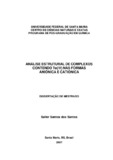| dc.creator | Santos, Sailer Santos dos | |
| dc.date.accessioned | 2017-05-25 | |
| dc.date.available | 2017-05-25 | |
| dc.date.issued | 2007-02-26 | |
| dc.identifier.citation | SANTOS, Sailer Santos dos. Structural analysis of complexes containing te(IV) in both cationic and anionic species. 2007. 111 f. Dissertação (Mestrado em Química) - Universidade Federal de Santa Maria, Santa Maria, 2007. | por |
| dc.identifier.uri | http://repositorio.ufsm.br/handle/1/10629 | |
| dc.description.abstract | In this work the synthesis and a detailed crystallochemical study of a series of complexes salts of Te(IV), with general formula [R3Te][PhTeX4] and [R3Te]2[TeX6], in
which Te(IV) atoms appears in both cationic and anionic species, are presented. (R= phenyl or methyl, and X = Cl, Br or I). Diphenylditelluride (PhTe)2 was adopted as starting material for the preparation of phenyltellurium(IV) trihalides (PhTeX3) and also for the obtaintion of dimethylphenyltellurium(IV) derivatives ([PhMe2Te]X). The triphenyltelluronium derivatives were obtained from the direct reaction between benzene, TeCl4 and AlCl3, producing [Ph3Te]Cl, that is converted to the bromide and iodide analogues by ion exchange with the proper silver halide. The complexes [PhMe2Te][PhTeCl4] (1), [PhMe2Te][PhTeBr4] (2), [PhMe2Te][PhTeI4] (3), [Ph3Te][PhTeCl4] (4), [Ph3Te][PhTeBr4] (5) and [Ph3Te][PhTeI4] (6) were obtained from the mixture of methanolic solutions of the phenyltellurium(IV) trihalides with the proper triorganyltelluronium halide. The complexes [PhMe2Te]2[TeCl6] (7), [PhMe2Te]2[TeBr6] (8), and [Ph3Te]2[TeBr6] (9) were obtained from the solution of the tellurium(IV) tetrahalide in the proper halohidric acid followed by the addition of the respective triorganyltelluronium halide. Monocrystalls were obtained from acetonitrile. The complexes synthesized show secondary bonds between tellurium and halogen atoms, and these interactions are responsible for the different structural arrangement of each compound. The degree of extension of the Te...X secondary bonds is
controlled by nature of the halogen bonded to tellurium and by the volume of the cation. | eng |
| dc.description.sponsorship | Conselho Nacional de Desenvolvimento Científico e Tecnológico | |
| dc.format | application/pdf | por |
| dc.language | por | por |
| dc.publisher | Universidade Federal de Santa Maria | por |
| dc.rights | Acesso Aberto | por |
| dc.subject | Telúrio(IV) | por |
| dc.subject | Ligações secundárias | por |
| dc.subject | Difração de raios-X | por |
| dc.subject | Tellurium(IV) | eng |
| dc.subject | Secondary bonds | eng |
| dc.subject | X-ray diffraction | eng |
| dc.title | Análise estrutural de complexos contendo te(IV) nas formas aniônica e catiônica | por |
| dc.title.alternative | Structural analysis of complexes containing te(IV) in both cationic and anionic species | eng |
| dc.type | Dissertação | por |
| dc.description.resumo | Este trabalho apresenta a síntese e o estudo cristaloquímico detalhado de uma série de sais complexos de telúrio(IV), de fórmulas gerais [R3Te][PhTeX4] e [R3Te]2[TeX6], nos quais átomos de telúrio(IV) estão presentes tanto no cátion como
no ânion, com R= fenila ou metila, e X = Cl, Br ou I. O ditelureto de difenila, (PhTe)2, foi utilizado como reagente de partida para a obtenção dos trialetos de feniltelúrio(IV)
e, também, para a síntese dos sais que contém a espécie monocatiônica de dimetilfeniltelúrio(IV). Os sais derivados do cátion trifeniltelurônio são obtidos através da reação direta de benzeno com TeCl4 e AlCl3, gerando [Ph3Te]Cl, que é convertido em bromo- e iodo- derivados por troca iônica. Os complexos [PhMe2Te][PhTeCl4] (1), [PhMe2Te][PhTeBr4] (2), [PhMe2Te][PhTeI4] (3), [Ph3Te][PhTeCl4] (4), [Ph3Te][PhTeBr4] (5) e [Ph3Te][PhTeI4] (6) são obtidos através da mistura dos trialetos de feniltelúrio(IV) com os respectivos haletos de triorganiltelúrio(IV) em metanol. Os complexos [PhMe2Te]2[TeCl6] (7), [PhMe2Te]2[TeBr6] (8), and
[Ph3Te]2[TeBr6] (9) são obtidos pela dissolução do tetra-haleto de telúrio(IV) em meio de ácido haloídrico apropriado, e posterior adição do derivado de telúrio(IV) catiônico na forma sólida. Todos os monocristais utilizados para difração de raios-X foram obtidos por recristalização em acetonitrila. Todos os complexos sintetizados apresentam ligações secundárias entre os átomos de telúrio e halogênio, sendo estas o fator determinante do arranjo estrutural apresentado por cada composto. O grau de ocorrência das ligações secundárias Te...X é controlado pela natureza do átomo de halogênio e pelo volume do cátion. | por |
| dc.contributor.advisor1 | Lang, Ernesto Schulz | |
| dc.contributor.advisor1Lattes | http://lattes.cnpq.br/4481982189769819 | por |
| dc.contributor.referee1 | Oliveira, Gelson Noe Manzoni de | |
| dc.contributor.referee1Lattes | http://lattes.cnpq.br/5103552511601104 | por |
| dc.contributor.referee2 | Gerbase, Annelise Engel | |
| dc.contributor.referee2Lattes | http://lattes.cnpq.br/1338228005253178 | por |
| dc.creator.Lattes | http://lattes.cnpq.br/2079205451835841 | por |
| dc.publisher.country | BR | por |
| dc.publisher.department | Química | por |
| dc.publisher.initials | UFSM | por |
| dc.publisher.program | Programa de Pós-Graduação em Química | por |
| dc.subject.cnpq | CNPQ::CIENCIAS EXATAS E DA TERRA::QUIMICA | por |


